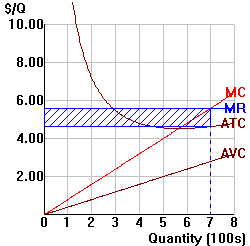| 2. | This question concerns the supplementary readings selection: F-22 Production OKs for Takeoff, http://faculty.oxy.edu/whitney/classes/ec250/tasks/h11_app.htm | ||
| a. | Suppose the cost information in Passage A and Passage B applies to an output level of 295 planes, with Passage A
reporting ATC and Passage B reporting a constant value for MC and AVC: ATC = $ 173 million AVC = MC = $ 84 million AFC = $ 89 million |
 |
|
| b. | TFC = $ 26,255 million | ||
| c. | Given the F-22's cost information, decide whether
ATC at Q=295 is rising, falling, constant, or moving in an uncertain direction, and briefly
indicate how you decided: Falling, since MC < ATC.
|
||
| d. | In the diagram to the right, sketch the MC, AVC and ATC curves for the F-22, and use numerical values to clearly label the F-22's MC and ATC values at its current output level of 295. | ||
